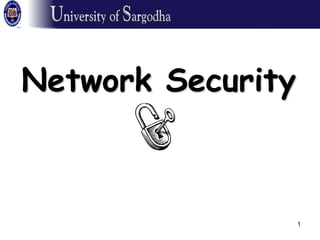
Chapter 1: Overview of Network Security
- 2. 2 Outline • Attacks, services and mechanisms • Security attacks • Security services • Methods of Defense • A model for Internetwork Security • Internet standards and RFCs
- 3. 3 Security? • COMPUTER SECURITY • The protection afforded to an automated information system in order to attain the applicable objectives of preserving the integrity, availability, and confidentiality of information system resources (includes hardware, software, firmware, information/ data, and telecommunications). (The NIST Computer Security Handbook [NIST95])
- 4. 4 Security? • What does it refer to? • Three Fundamentals – Confidentiality (Data confidentiality, Privacy) • Authorized users get entry • Inspection of information, printing of information and knowledge of resource existence – Availability • Legitimate user be able to access resources and service should be provided at anytime – Integrity (Data integrity & System integrity) • Changed in adequate way • Modification done by authorized people
- 6. 6 Attack Process • Three stages called MOM • Method – Ability, information, tools • Opportunity – Time and Access • Motive – Testing system reliability – Competition between attackers or testing their own skills – Breaking into well secured systems like law enforcement, government agencies – To gain popularity, financial gain, information gain – Just for fun – No motive at all
- 7. 7 The OSI (open systems interconnection) security architecture • Security Attack: Any action that compromises the security of information. • Security Mechanism: A mechanism that is designed to detect, prevent, or recover from a security attack. • Security Service: A service that enhances the security of data processing systems and information transfers. A security service makes use of one or more security mechanisms.
- 8. 8 Security Attacks • Passive Attack • Passive attacks are in the nature of eavesdropping on, or monitoring of, transmissions. The goal of the opponent is to obtain information that is being transmitted – attempts to learn or make use of information from the system but does not affect system resources • Active Attack – attempts to alter system resources or affect their operation – Active attacks involve some modification of the data stream or the creation of a false stream and can be subdivided into four categories
- 9. 9 *masquerade: pretends to be authorised user to get higher privileges
- 10. 10 Security Attacks • Interruption: This is an attack on availability • Interception: This is an attack on confidentiality • Modification: This is an attack on integrity • Fabrication: This is an attack on authenticity
- 12. 12 Security Services • Processing or communication service that is provided by a system to give a specific kind of protection to system resources; security services implement security policies and are implemented by security mechanisms – Confidentiality (protect data from unauthorized disclosure) – Authentication (who created or sent the data) – Data Integrity (has not been altered) – Non-repudiation (the order is final) Non repudiation prevents either sender or receiver from denying a transmitted message. Thus, when a message is sent, the receiver can prove that the alleged sender in fact sent the message. Similarly, when a message is received, the sender can prove that the alleged receiver in fact received the message. – Access control (prevent misuse of resources) – Availability (property of a system or a system resource being accessible and usable upon demand by an authorized system entity) • Denial of Service Attacks
- 13. 13
- 14. 14 Methods of Defense • Encryption • Software Controls (access limitations in a data base, in operating system protect each user from other users) • Hardware Controls (smartcard) • Policies (frequent changes of passwords) • Physical Controls
- 15. 15 Example • A security-related transformation on the information to be sent. Examples include the encryption of the message, which scrambles the message so that it is unreadable by the opponent, and the addition of a code based on the contents of the message, which can be used to verify the identity of the sender. • Some secret information shared by the two principals and, it is hoped, unknown to the opponent. An example is an encryption key used in conjunction with the transformation to scramble the message before transmission and unscramble it on reception.
- 16. 16
